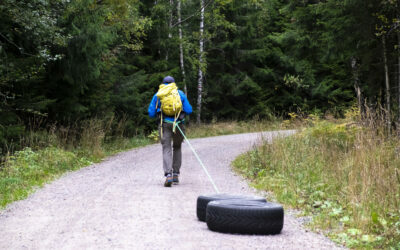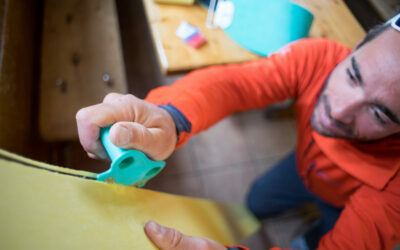Positivity – positive reinforcement
Taking a dog out on a tour is a bit like taking out a child. For the best experience for everyone, it’s important that your dog gets gradually used to the activity. And it’s extremely important that the dog is trained positively – that positive rewards are used to teach them new things. We can talk about dog training all day – but one thing’s certain. Positive training and positive reinforcement work best. A dog that’s punished or has negative experiences on a trip out will not be a happy and pleasant creature “på tur”. So it’s pretty vital to take some time to get used to the exercise, giving the dog many positive and controlled experiences before setting off on a proper “expedition”. You can begin art as simply as camping outside your cabin, in the garden, or near at first. When you first get started, you’ll soon realise that your dog needs some time to get used to the sleeping bag, the tent, cooking in the tent, new feeding routines and long walks. Start small. Make it positive. Work up to it.
Crister and his dog Tøys out on a tour of Vikafjellet. Photo: Crister Næss / @toysworkingspaniel
7 tips for beginners with dogs in winter
TAKING DOGS OUT IN THE AUTUMN AND WINTER
Winter and autumn are a wonderful time for us and our four-legged hiking friends alike. There are many experiences, beautiful light, and gorgeous contrasts in nature. But there are also challenges, or rather, some things to think about, if you take your dog out under the skies. Although most dogs have fur, this doesn’t mean that they can’t freeze. Dogs can get frostbite too, so it’s important that we as dog owners make sure it doesn’t happen. A cold dog tires out more quickly. It can get sick or become exhausted in no time – not unlike us humans. For freezing dogs, the problem isn’t only temperature; wind and humidity are also important factors.Do all dogs freeze the same?
It depends on the dog. As with us humans, some people freeze more than others, some less. In the case of dogs, it depends on what kind of fur the dog has, and on how much it is in the habit of being outside on a regular basis. Certain breeds, among them “polar dogs” such as huskies, are bred to withstand the cold better than others. With the exception of nordic and polardog breeds in particular, all dogs suffer from low temperatures just like humans do. You have to be extra careful if your dog is sick (especially if this is a respiratory problem), or if you have a puppy, an old, a small, or a short-haired dog. Sick dogs will find it extra difficult to keep warm in winter.Some things to think about when you’re going out with a dog into the cold.
The easiest way to prevent a dog from freezing is to keep it active. If it is really bitterly cold outside, it’s better to take short, active, walks than longer walks at a leisurely pace. You should also let the dog wear a jacket or a heated blanket when you head out. It has become common (fortunately) to discuss the fact that a dog shouldn’t be left in the heat or in the car in the summer, so that it can be comfortable in the cool. The same applies to the cold in winter!How to take care of your dog outdoors
If you take some precautions, plan and prepare a little, then the excursion with your dog will be easier. On cold days out, there are some factors in particular that have to be taken care to make sure your dog doesn’t get hurt. We’ll break them down.
Where is your dog the most exposed?
Ears, tail and especially paws, nipples and scrotum – all salient extremities are vulnerable to frostbite.
Feeding a dog on a winter tour
It can be difficult to feed a dog properly when you’re out in the wilderness. In winter especially, when you have to think a little harder to make sure you always have enough water for both yourself and the dog. The water shouldn’t be too cold. Cold water requires more energy from the body, both for humans and dogs. The body reacts to the cold and automatically attempts to bring the water up to body temperature. The same applies to food. The body requires energy to digest food; if the food’s freezing cold (or scalding hot, for that matter) the more energy’s required. A nutritious and balanced diet of good quality food is important for both humans and animals. In cold weather, we have to take care that our non-human friends get food appropritate to their size, age, species, breed and activity level. It doesn’t really matter if it’s made at home or bought ready-made at the pet store.. If our four-legged tour-companions eat well, their immune systems function at strength. But it’s important not to mix quality and quantity. Over-frequent feeding of the dog will make it overweight. This brings negative consequences. On extremely cold and extremely hot days, especially, our dogs will almost certainly be less active, so we should adjust the amount we feed them appropriately. This is actually a general, everyday rule: be sure to adjust quantities of food to account for size (how fat the dog is), conditions, and activity. Cold is as challenging for dogs as it is for humans, if not more so. So it’s important that we, as dog owners, take care of our dogs in the cold. Make sure they have a good diet, that their hygiene is taken care of, and that they’re protected from sudden temperature changes.
Dressing for adventure: what to wear in the wild
Norwegian grandmothers have it right: always wear wool against the skin. Beginning with wool as the first layer, the three-layer principle applies. Step this way for a guide to wrapping up warm in the wild.

Planning a tour
“Better safe than sorry” doesn’t mean you have to be anxious- Planning isn’t just something that makes your trip to the mountains safer – it’s a source of inspiration.

Menstruating on skis
Periods. Because we menstruate in winter too. Stomach cramps while overnighting in the wild aren’t often discussed – which means they ought to be. So curl up with some ibuprofen and a glass of water for some good tips for menstruating in the winter mountains.

Tyre training
Get started with tyre training – the best way to prepare for an expedition or the coming ski season.

Building a winter windbreak for you tent
To build a windbreak from snow, or not to build a windbreak from snow? This question comes up a lot. Here’s our advice – with a tip for those who’d rather not make the effort…

Tailoring long skins for alpine touring
Wondering how to tailor your skins for alpine touring? Here’s an overview – care and trimming long skins for touring skis.